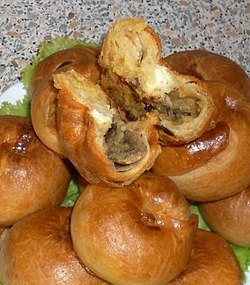Knish
This article needs additional citations for verification. (May 2021) |
 Knishes with mashed potato and fried onions | |
| Alternative names | Knysh |
|---|---|
| Type | Snack, side dish, finger food |
| Region or state | United States, Israel , other countries with a significant remaining Ashkenazi Jewish population |
| Created by | Jewish communities in Central and Eastern Europe |
| Main ingredients | Mashed potatoes, dough, ground meat, sauerkraut, onions, kasha, cheese |
A knish /kəˈnɪʃ/ is a traditional Ashkenazi Jewish[1] snack food consisting of a filling covered with dough that is typically baked or sometimes deep fried.
Knishes are usually purchased from street vendors in urban areas with a large Jewish population, sometimes at a hot dog stand or from a butcher shop. It is still strongly associated with New York City, the New York City region, and New York City cuisine.[clarification needed] It was made popular in North America by Ashkenazi Jewish refugees from the Pale of Settlement (mainly from present-day Belarus, Lithuania, Ukraine, and eastern Poland).[2]
In most traditional versions, the filling is made entirely of mashed potato, kasha (buckwheat groats), or cheese. Other varieties of fillings include sweet potatoes, black beans, or spinach.
Knishes may be round, rectangular, or square. They may be entirely covered in dough or some of the filling may peek out of the top. Sizes range from those that can be eaten in a single bite hors d'oeuvre to sandwich-sized.
History in the United States[]
Ashkenazi Jewish immigrants who arrived sometime around 1900 brought knishes to the United States.[3] Knish (קניש) is a Yiddish word that was derived from the Ukrainian knysh (книш) and Polish knysz.[4][5] The first knish bakery in America was founded in New York City in 1910.[6] Generally recognized as a food made popular in New York City by Jewish immigrants in the early 20th century, the United States underwent a knish renaissance in the 2000s driven by knish specialty establishments such as the Knish Shop in Baltimore, Maryland,[7] Buffalo and Bergen[8] in Washington, DC, or My Mother's Knish,[9] in Westlake Village, California.
In the 20th century New York City and state politicians portrayed themselves eating knishes to show solidarity with Jewish working class people. The trend declined after suburbanization and the policies of Ed Koch and Rudy Giuliani made policies that restricted the sale of knishes from food carts.[10]
See also[]
- Jewish cuisine – culinary traditions of Jewish communities around the world
- Israeli cuisine – Israeli cuisine
- Turnover
- Yonah Shimmel's Knish Bakery
References[]
- ^ Wasserman, Tina. "Cooking: The Ultimate Jewish Finger Food". Reform Judaism Magazine. Archived from the original on December 22, 2010. Retrieved 2010-09-14.
- ^ Silver, Laura (May 6, 2014). Knish: In Search of the Jewish Soul Food. Waltham, Mass.: Brandeis University Press. ISBN 978-1-61168-312-7.
- ^ Smith, Andrew F. (May 2007). The Oxford Companion to American Food and Drink – Google Boeken. ISBN 9780195307962. Retrieved 2013-01-21.
- ^ "Judaism 101: Jewish Cooking". Jewfaq.org. Retrieved 2013-01-21.
- ^ "knish – definition of knish by the Free Online Dictionary, Thesaurus and Encyclopedia". Thefreedictionary.com. Retrieved 2013-01-21.
- ^ (Kugel, Knishes, and Other Tasty Dishes by Nina Yellin, 2001)
- ^ "The Knish Shop, Baltimore". Jewishinbaltimore.com. Retrieved 2013-01-21.
- ^ "Gina Chersevani's Union Market Soda Shop and Bar Will Be Called Buffalo and Bergen | Food & Restaurant News". Washingtonian. 2012-05-24. Retrieved 2013-01-21.
- ^ Alan RichmanPhotograph by Martin O'Neill. "A Mother's Knishes: Alan Richman". GQ. Retrieved 2013-01-21.
- ^ Silverstein, Andrew (2021-04-07). "Once the staple of New York politics, whatever became of the knish?". Forward. Retrieved 2021-04-15.
External links[]
- Jewish baked goods
- Ashkenazi Jewish cuisine
- Dumplings
- Potato dishes
- Savoury pies
- Cuisine of New York City
- Snack foods
- Street food
- Jewish cuisine
